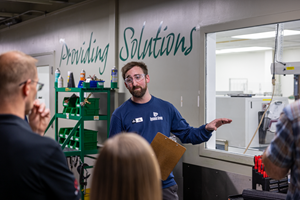Are You Ready to Export Your Film?
The shale gas boom could provide unprecedented opportunities for film processors.
I’ve blogged about shale gas before. I’ve also written an editorial about it. And my colleague Lilli Sherman wrote a comprehensive piece on the subject in our November issue. We pay so much attention to this topic because it has the potential to revolutionize plastics processing in North America.
More recently, I received a press release last week from Applied Market Information, which was promoting the release of a multi-client study it conducted last year, Polyethylene Film Products: The Global Market.
Whenever I get studies like this the first thing I start to wonder about is whether the cost reductions that suppliers realize as a result of shale-gas developments will trickle down to the processor, our audience. The consensus is, not right away, if at all. Noted AMI’s John Campin: “I don't think there will be any dramatic shift in relative cost base in North America until after 2018: quite a lot will depend on how many of the proposed PE installations will go ahead.”
But then I started to wonder if I was asking the right question in the first place. In a way, yes…price is important to buyers of PE because many of them purchase it in large quantities. A swing of a penny a pound either way makes a huge difference. And, yes, there will be tremendous amounts of material produced by polyolefin suppliers from lower-cost feedstocks over the next few years. Should not these cost savings trickle down to processors? I mean, in some extrusion operations material accounts for 60-70% of their total manufacturing expenses. Not chump change.
Then I started to think "big picture." Relatively speaking, because shale gas is being generated across North America, the price for polyolefins paid by processors in this continent stand to be very competitive with those paid by processors located most everywhere else. So there’s an unprecedented opportunity for well-positioned processors to expand their business outside North America. According to the study, “It is highly probable that North America will have a polymer cost base on a par with that in the Middle East, leading to PE film exports from North America overtaking those of the Middle East. Looking beyond 2018, this projected cost advantage, when combined with the technological expertise of U.S. polyethylene film producers, will ensure North American PE film producers become truly global players.”
Where specific film applications are concerned, the study says the highest growth rate is forecast for stretch films. Demand for bags and sacks is also forecast to grow, as is growth of technical films, agricultural films, heavy duty sacks and shrink films.
While all of that is exciting and looks great on paper, it won't come to pass without effort on the part of processors. One thing film processors in particular must reevaluate is equipment. One industry source estimates that more than 70% of the 20 billion lb/yr of blown film is currently processed on equipment that’s 10 years old or older. As I see it, film producers will still be leaving money and opportunities on the table if they continue to run it through equipment that doesn’t offer the latest capabilities in throughput, gauge control and quality. Another issue North American processors must do is begin to establish overseas channels, either through sales representation or regional offices. Take note: European film producers are already starting to gain a foothold in North America.
So the shale gas opportunity is there. It’s not too early to start planning.
Contact John Campin for more details on this study.

Related Content
Formulating LLDPE/LDPE Blends For Abuse–Resistant Blown Film
A new study shows how the type and amount of LDPE in blends with LLDPE affect the processing and strength/toughness properties of blown film. Data are shown for both LDPE-rich and LLDPE-rich blends.
Read MoreHow to Extrusion Blow Mold PHA/PLA Blends
You need to pay attention to the inherent characteristics of biopolymers PHA/PLA materials when setting process parameters to realize better and more consistent outcomes.
Read MoreMedical Molder, Moldmaker Embraces Continuous Improvement
True to the adjective in its name, Dynamic Group has been characterized by constant change, activity and progress over its nearly five decades as a medical molder and moldmaker.
Read MoreFoam-Core Multilayer Blow Molding: How It’s Done
Learn here how to take advantage of new lightweighting and recycle utilization opportunities in consumer packaging, thanks to a collaboration of leaders in microcellular foaming and multilayer head design.
Read MoreRead Next
People 4.0 – How to Get Buy-In from Your Staff for Industry 4.0 Systems
Implementing a production monitoring system as the foundation of a ‘smart factory’ is about integrating people with new technology as much as it is about integrating machines and computers. Here are tips from a company that has gone through the process.
Read MoreWhy (and What) You Need to Dry
Other than polyolefins, almost every other polymer exhibits some level of polarity and therefore can absorb a certain amount of moisture from the atmosphere. Here’s a look at some of these materials, and what needs to be done to dry them.
Read More












.png;maxWidth=300;quality=90)











.png;maxWidth=970;quality=90)